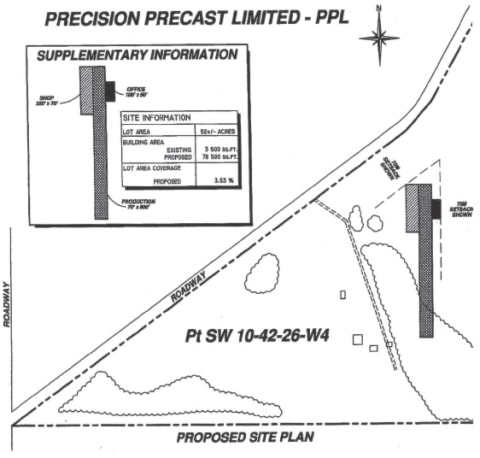A state of the art precast concrete plant is hoping to move onto 52 acres of land north of the Wolf Creek Golf Resort and along Highway 2, if a land rezoning application goes through.
Precision Precast Ltd., currently located in Lacombe, attended the Nov. 6 meeting of Ponoka County council. Tom Kentz with Precision Precast, and partner Harold Jahn, are hoping to have the agricultural land rezoned to rural industrial.
“We looked at a number of sites throughout the province and we thought this would be a good, centrally located site,” said Jahn. “Part of the reason this was selected is it’s not farmland, it’s a marginal piece of property.”
Jahn says the location will also have good exposure for clients.
Also at the meeting was Ryan Andres, municipal planner with West Central Planning Agency (WCPA). According to WCPA the land is slightly north of an area designated as a possible industrial site, and they support the rezoning.
“According to the county’s land use bylaw the purpose of this district is to provide land for industry and for the resource extraction operations in locations which will not conflict with nearby agricultural and residential land uses. This is a suitable designation for the proposal,” said Andres.
CAO Charlie Cutforth said Alberta Transportation also supports rezoning the land.
Near the beginning of the public hearing Cutforth read a letter of objection of a land owner in the area, Dean MacLeod. MacLeod is concerned about land values, tax bases, emissions, noise, odors, water consumption and local employment.
After the letter Kentz and Jahn took the time to address some of the concerns and explain their operation. “Land value is really based on the use of the property,” said Jahn
As for noise levels, the plant will produce between 70 and 80 decibels and the process is enclosed within the building. Jahn says there will be no noisy equipment. Outside there will be only a forklift and a gentry crane.
The process will use 40 per cent less water than other processes to make cement products, said Jahn. “It’s an insulated wall product.”
There are two wells on the land with 18 and 20 gallons per minute. Their process will use 10 cubic metres of water per day. “And we recycle most of that water,” said Jahn.
He also said if the roof is designed right rainwater can be collected and used for the process.
“There are no emissions from this product, no air emissions at all. Basically we’re pouring cement into forms,” he added.
Jahn ways the operating hours of the plant will be approximately between 7 a.m. and 7 p.m. “Most of it will be indoors and we’d have about six trucks per day coming in and out of the site.”
Due to the topography of the landsite, and the design of the 140 by 800 foot glass and concrete building, Jahn says adjacent land owners won’t be able to see the building unless driving on the highway.
“In terms of employees, we’re looking at between 15 and 30. About one-third of them being office type work, and a few for trucking,” said Jahn.
Approximately six employees would come from Lacombe, where a small plant is currently located, and the rest would be hired locally and trained. Jahn said students could also be hired and trained for office and marketing jobs.
Kentz says with their process they can use 10 people where other processes may need 50 to do the same amount of work.
“The products that are going to be built are mainly wall panels used in walls, floors, ceilings, basements and eventually complete concrete homes will be made from the product,” said Jahn. “All the products are biodegradable. There’s no waste generated at the site.”
Right now the plant in Lacombe can’t keep up with business demands. Jahn said they’re turning away between $10 million and $15 million per year. Sales to date are $4 million.
A basic drawing of the building was shown halfway the meeting and it was then that Coun. Gawney Hinkley told Jahn and Kentz he wanted to table the decision.
Even after the explanation, several landowners were still on the fence about having the building, and several outbuildings added in the future, on that land.
“The fella’s got a good plan. I’d like to see this in Ponoka County. But the area they’re suggesting is wrong. They say the farmland is marginal, it’s not,” said Ray Reid.
“We need time, we need time for this. You guys are currently pouring hollow cast?” asked Jason Reid.
Jahn answered no to his question.
They’ve haven’t poured the hollow cast product yet but have been in business for several years and say there is a high demand for the product and not many suppliers. A plant in Wisconsin was visited and that’s one of the sources the numbers such as water content came from.
Jason Reid wanted to see more solid numbers in their plans. “I don’t believe the water content and I don’t believe the six cars per day.”
He said he has experience in installing precast and believes there could be 16 to 20 trucks for one building. Plus all the materials must be brought on site Jason Reid said. “The C and E Trail is not going to take that.”
“I’m all for development, I’m all for pushing ahead. I’m all for all of that stuff. This is the wrong place.” Like Hinkley, he wanted to see a more detailed drawing of the building.
The decision was given a first reading, which Hinkley and Coun. Keith Beebe opposed. It was given a second reading but no further decisions will be made until the next council meeting on Nov. 27.
